The Annapurna region of Nepal is a popular destination for trekkers, located in the north-central part of the country. The region is home to the Annapurna massif, a range of peaks over 8,000 meters (26,247 feet) high, including Annapurna South, Annapurna I, and Annapurna II. The region is also home to a diverse array of flora and fauna, as well as a rich cultural heritage.
There are several trekking routes in the Annapurna region, ranging from short, easy treks to longer, more challenging routes. The most popular trek is the Annapurna Base Camp trek, which takes you to the base of the Annapurna massif. The trek begins in Pokhara, a city in central Nepal, and follows the Modi Khola river to Ghandruk, a village in the Annapurna region. From Ghandruk, the trek continues to Chomrong, Dovan, and Deurali, with a side trip to Poon Hill for views of the Annapurna peaks and the Dhaulagiri massif. The final destination of the trek is the Annapurna Base Camp, located at an elevation of 4,130 meters (13,550 feet).
The Annapurna Base Camp trek is considered to be a moderate trek, suitable for trekkers with some previous hiking experience. The trek involves hiking through diverse landscapes, including forests, terraced fields, and villages, and offers views of the Annapurna peaks and the surrounding mountain ranges. The trek can be done throughout the year, although the weather is generally most favorable in the spring (March to May) and fall (September to November) seasons.
The cost of the Annapurna Base Camp trek can vary depending on a number of factors, such as the duration of the trek, the level of accommodation, and the mode of transportation. On average, you can expect to pay around $800 to $1,500 for the entire trek, including all meals, accommodation, and transportation.
It is not strictly necessary to hire a guide for the Annapurna Base Camp trek, as the route is well-marked and relatively easy to follow. However, hiring a guide can be a good idea for several reasons. A guide can provide valuable information about the local culture, flora, and fauna, and the history of the region. They can also help
 Mohare Danda Trek
Duration: 5 days | Grade: Easy
Mohare Danda Trek
Duration: 5 days | Grade: Easy 6 Days Annapurna Circuit Short Trek
Duration: 6 days | Grade: Moderate
6 Days Annapurna Circuit Short Trek
Duration: 6 days | Grade: Moderate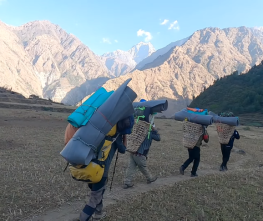 North Annapurna Base Camp Trek
Duration: 7 days | Grade: Moderate
North Annapurna Base Camp Trek
Duration: 7 days | Grade: Moderate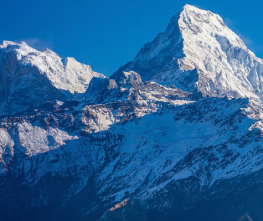 3 Days Short Ghorepani Poon Hill Trek
Duration: 3 days | Grade: Easy
3 Days Short Ghorepani Poon Hill Trek
Duration: 3 days | Grade: Easy Upper Mustang Motorbike Tour
Duration: 10 days | Grade: Strenuous
Upper Mustang Motorbike Tour
Duration: 10 days | Grade: Strenuous Annapurna Circuit & Annapurna Base Camp Trek Fusion
Duration: 20 days | Grade: Moderate
Annapurna Circuit & Annapurna Base Camp Trek Fusion
Duration: 20 days | Grade: Moderate 5 Days Annapurna Base Camp (ABC) Trek
Duration: 5 days | Grade: Moderate
5 Days Annapurna Base Camp (ABC) Trek
Duration: 5 days | Grade: Moderate Mardi Himal Trek Price for Nepali
Duration: 4 days | Grade: Easy
Mardi Himal Trek Price for Nepali
Duration: 4 days | Grade: Easy 3-day Mardi Himal Trek
Duration: 3 days | Grade: Easy
3-day Mardi Himal Trek
Duration: 3 days | Grade: Easy 14 day Annapurna Circuit trek from Kathmandu
Duration: 14 days | Grade: Moderate
14 day Annapurna Circuit trek from Kathmandu
Duration: 14 days | Grade: Moderate Annapurna base camp trek via Ghorepani
Duration: 10 days | Grade: Moderate
Annapurna base camp trek via Ghorepani
Duration: 10 days | Grade: Moderate Poon Hill Trek and Dasain Festival Package
Duration: 13 days | Grade: Moderate
Poon Hill Trek and Dasain Festival Package
Duration: 13 days | Grade: Moderate Ghorepani Poon hill Package Trekking
Duration: 5 days | Grade: Moderate
Ghorepani Poon hill Package Trekking
Duration: 5 days | Grade: Moderate Adventure and Luxury Combined Annapurna Base Camp Trek with a Helicopter Exit
Duration: 10 days | Grade: Moderate
Adventure and Luxury Combined Annapurna Base Camp Trek with a Helicopter Exit
Duration: 10 days | Grade: Moderate ABC Trek
Duration: 7 days | Grade: Moderate
ABC Trek
Duration: 7 days | Grade: Moderate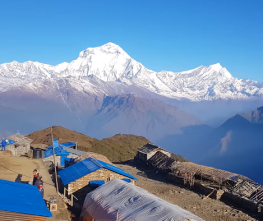 Short Khopra Ridge Trek
Duration: 7 days | Grade: Moderate
Short Khopra Ridge Trek
Duration: 7 days | Grade: Moderate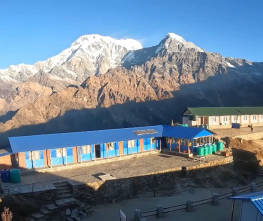 Mardi Himal Trek on a Tight Budget
Duration: 3 days | Grade: Moderate
Mardi Himal Trek on a Tight Budget
Duration: 3 days | Grade: Moderate Short and Budget Annapurna Circuit Trek
Duration: 7 days | Grade: Moderate
Short and Budget Annapurna Circuit Trek
Duration: 7 days | Grade: Moderate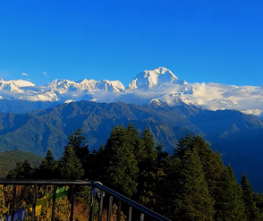 Budget Ghorepani trek
Duration: 3 days | Grade: Easy
Budget Ghorepani trek
Duration: 3 days | Grade: Easy 2 days Poon Hill Trek
Duration: 2 days | Grade: Easy
2 days Poon Hill Trek
Duration: 2 days | Grade: Easy Budget-Friendly Annapurna Circuit Trek
Duration: 10 days | Grade: Strenuous
Budget-Friendly Annapurna Circuit Trek
Duration: 10 days | Grade: Strenuous Machhapuchhre Model trek
Duration: 9 days | Grade: Moderate
Machhapuchhre Model trek
Duration: 9 days | Grade: Moderate Ghorepani trek 5 days from Pokhara
Duration: 5 days | Grade: Easy
Ghorepani trek 5 days from Pokhara
Duration: 5 days | Grade: Easy 3 Days Ghandruk Loop Trek
Duration: 3 days | Grade: Easy
3 Days Ghandruk Loop Trek
Duration: 3 days | Grade: Easy Budget Muktinath tour package
Duration: 7 days | Grade: Easy
Budget Muktinath tour package
Duration: 7 days | Grade: Easy Ghorepani Poon Hill Trek
Duration: 5 days | Grade: Easy
Ghorepani Poon Hill Trek
Duration: 5 days | Grade: Easy Mardi Himal 7 days Trek
Duration: 7 days | Grade: Moderate
Mardi Himal 7 days Trek
Duration: 7 days | Grade: Moderate Annapurna Sunrise Trekking
Duration: 5 days | Grade: Easy
Annapurna Sunrise Trekking
Duration: 5 days | Grade: Easy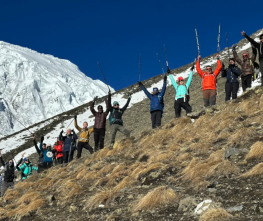 Annapurna Circuit Trek in 15 Days
Duration: 15 days | Grade: Moderate
Annapurna Circuit Trek in 15 Days
Duration: 15 days | Grade: Moderate Short Poon Hill Trek
Duration: 4 days | Grade: Easy
Short Poon Hill Trek
Duration: 4 days | Grade: Easy Sarangkot and Dhampus hiking
Duration: 3 days | Grade: Easy
Sarangkot and Dhampus hiking
Duration: 3 days | Grade: Easy Budget Annapurna base camp Trek
Duration: 5 days | Grade: Moderate
Budget Annapurna base camp Trek
Duration: 5 days | Grade: Moderate Tilicho lake and Thorong la pass trek
Duration: 21 days | Grade: Strenuous
Tilicho lake and Thorong la pass trek
Duration: 21 days | Grade: Strenuous Sarangkot Hiking from Pokhara
Duration: 3 days | Grade: Easy
Sarangkot Hiking from Pokhara
Duration: 3 days | Grade: Easy Poon Hill Sunrise Trekking
Duration: 5 days | Grade: Easy
Poon Hill Sunrise Trekking
Duration: 5 days | Grade: Easy Poon Hill Trek and Chitwan Jungle Safari
Duration: 8 days | Grade: Easy
Poon Hill Trek and Chitwan Jungle Safari
Duration: 8 days | Grade: Easy Mini Annapurna Circuit Trekking
Duration: 13 days | Grade: Moderate
Mini Annapurna Circuit Trekking
Duration: 13 days | Grade: Moderate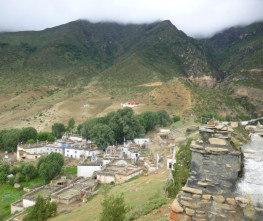 Jomsom Short Trek
Duration: 14 days | Grade: Moderate
Jomsom Short Trek
Duration: 14 days | Grade: Moderate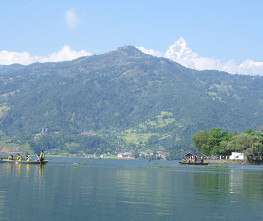 Australian Camp and Sarangkot Hiking
Duration: 3 days | Grade: Easy
Australian Camp and Sarangkot Hiking
Duration: 3 days | Grade: Easy Short 8 days Annapurna Base Camp Trek
Duration: 8 days | Grade: Moderate
Short 8 days Annapurna Base Camp Trek
Duration: 8 days | Grade: Moderate Mardi Himal Short Trek
Duration: 12 days | Grade: Moderate
Mardi Himal Short Trek
Duration: 12 days | Grade: Moderate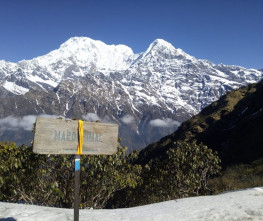 Budget Trekking in Nepal
Duration: 7 days | Grade: Easy
Budget Trekking in Nepal
Duration: 7 days | Grade: Easy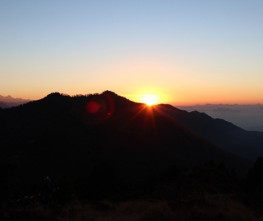 Sarankot Sunrise Tour
Duration: 7 days | Grade: Easy
Sarankot Sunrise Tour
Duration: 7 days | Grade: Easy Annapurna trekking and Volunteering
Duration: 8 days | Grade: Easy
Annapurna trekking and Volunteering
Duration: 8 days | Grade: Easy Annapurna Panchase Hill Trekking
Duration: 10 days | Grade: Easy
Annapurna Panchase Hill Trekking
Duration: 10 days | Grade: Easy Khopra Trek
Duration: 8 days | Grade: Moderate
Khopra Trek
Duration: 8 days | Grade: Moderate Upper Mustang Trekking
Duration: 13 days | Grade: Moderate
Upper Mustang Trekking
Duration: 13 days | Grade: Moderate